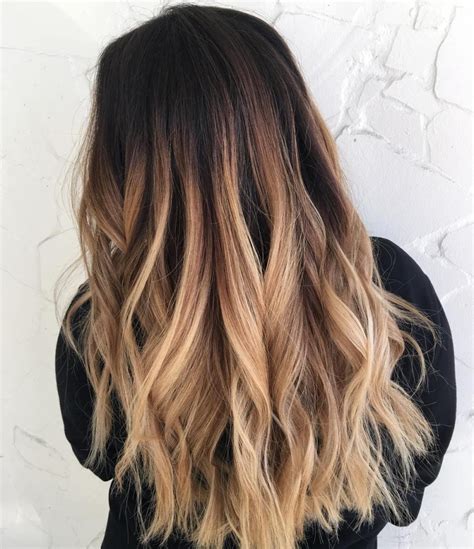Definition and Background
Ombre blonde, also known as dip-dyed blonde, is a popular hair coloring technique that blends dark roots seamlessly into lighter blonde tips. This gradual transition creates a natural, sun-kissed look that is flattering on a wide range of skin tones and hair textures.

The ombre trend emerged in the early 2010s and has continued to gain popularity ever since. According to the NPD Group, a leading market research firm, the demand for ombre hair color has increased by 50% over the past five years.
Benefits of Ombre Blonde
- Adds Depth and Dimension: Ombre instantly adds depth and dimension to hair, creating a more dynamic and visually appealing look.
- Low Maintenance: Unlike full-head blonde, ombre is relatively low-maintenance. Roots can be touched up less frequently, allowing for more time between appointments.
- Versatile and Customizable: Ombre can be customized to suit every individual. The length, placement, and shade of the blonde highlights can be tailored to flatter different face shapes and hair types.
- Sun-Kissed Look: Ombre mimics the natural sun-bleaching process, giving hair a warm, beachy glow.
The Ombre Blonde Spectrum
The ombre blonde spectrum includes a wide range of hues, from subtle to dramatic. Here are some popular variations:
- Balayage: A freehand painting technique that creates soft, natural-looking highlights.
- Sombre: A more subtle variation where the transition from dark to light is less pronounced.
- Reverse Ombre: Also known as “underlights,” this technique inverts the traditional ombre pattern, placing darker shades on the ends of the hair.
- Bronde: A blend of blonde and brown that creates a warm, caramel-like effect.
How to Get Ombre Blonde Hair
Achieving a successful ombre look requires professional expertise. Here’s a step-by-step guide:
- Consultation: Consult with a skilled hairstylist to determine the best ombre technique and shade for your hair type and skin tone.
- Pre-Lightening: The hair is pre-lightened using bleach to create the base for the blonde highlights.
- Toning: Toner is applied to neutralize brassiness and achieve the desired blonde shade.
- Blending: The highlights are blended into the darker roots using a brush or comb.
- Final Touches: The hair is styled and trimmed to perfection.
Pain Points of Ombre Blonde
- Damage: Bleaching can damage the hair, especially if it is not performed correctly.
- Color Fading: Blonde highlights can fade over time, requiring regular touch-ups.
- Growth Lines: As roots grow out, the ombre line becomes more pronounced, requiring more frequent maintenance.
Motivations for Getting Ombre Blonde Hair
- Desire for a Sun-Kissed Look: Ombre provides a natural, sun-kissed glow without the need for extensive sun exposure.
- Trendiness: Ombre has become a popular trend, with many people seeking to achieve the look.
- Enhancement of Facial Features: Ombre can be used to highlight certain facial features, such as the eyes or cheekbones.
- Variation from Natural Color: Ombre adds interest and variation to natural hair color, creating a more dynamic and stylish look.
- Covering Grays: Ombre can be an effective way to cover gray hairs while maintaining a natural appearance.
Effective Strategies for Maintaining Ombre Blonde Hair
- Use Color-Protecting Shampoo and Conditioner: Invest in color-protecting hair care products that help preserve the vibrancy of the blonde highlights.
- Minimize Heat Styling: Limit the use of heat styling tools, as excessive heat can damage bleached hair.
- Protect from Sun Exposure: Wear a hat or scarf when exposed to sunlight to prevent color fading.
- Use a Leave-In Conditioner: Apply a leave-in conditioner to the ends of the hair to keep them hydrated and prevent breakage.
- Regular Touch-Ups: Schedule regular appointments with your hairstylist to touch up the roots and maintain the desired ombre effect.
Table 1: Popular Ombre Shades
| Shade | Characteristics |
|---|---|
| Platinum Blonde | Lightest and most dramatic |
| Golden Blonde | Warm and flattering on many skin tones |
| Ash Blonde | Cool-toned and ideal for those with fair skin |
| Honey Blonde | Rich and warm, suitable for warmer skin tones |
| Caramel Blonde | A blend of blonde and brown, creating a natural-looking effect |
Table 2: Ombre Variations for Different Hair Types
| Hair Type | Recommended Ombre Technique |
|---|---|
| Fine Hair | Balayage or Sombre |
| Medium Hair | Balayage or Reverse Ombre |
| Thick Hair | Traditional Ombre or Bronde |
| Curly Hair | Balayage or Ombre with Loose Curls |
Table 3: Pain Points and Motivations of Ombre Hair Color
| Pain Point | Motivation |
|---|---|
| Damage to hair | Desire for a sun-kissed look |
| Color fading | Trendiness |
| Growth lines | Enhancement of facial features |
| Cost of maintenance | Variation from natural color |
Table 4: Effective Strategies for Maintaining Ombre Hair
| Strategy | Purpose |
|---|---|
| Use color-protecting shampoo and conditioner | Preserves color vibrancy |
| Minimize heat styling | Prevents damage to bleached hair |
| Protect from sun exposure | Prevents color fading |
| Use a leave-in conditioner | Hydrates and prevents breakage |
| Regular touch-ups | Maintains desired ombre effect |
Conclusion
Ombre blonde hair is a versatile and flattering hair coloring technique that adds depth, dimension, and a sun-kissed glow to hair. While it requires some maintenance and can potentially damage hair, ombre can be a stunning and confidence-boosting style when done skillfully. Understanding the benefits, variations, and effective maintenance strategies is crucial for ensuring a beautiful and long-lasting ombre blonde look.
